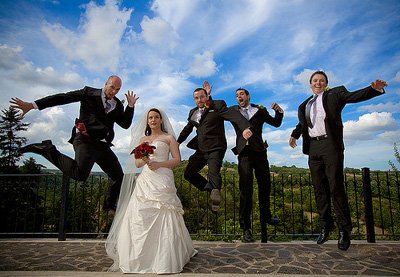 |
Wedding Photography Lighting Tips, Techniques And Equipment For Indoor And Outdoor Wedding Photography
|
|
Use these wedding photography lighting tips, techniques and equipment to help you get the best shots of the big day.
The wedding day is a major, once in a lifetime, event for any couple and making sure that it’s properly captured is a big responsibility for the photographer.
When you’re asked to take the wedding photographs, one of the most important elements of the wedding photography to plan for, is the lighting.
Whether you're taking the wedding pictures indoors or outdoors, these wedding photography lighting tips will help you be prepared for every event.
 |
Outdoor Wedding Photography Techniques
Most couples will want the photographs taken outside, but if the weather turns nasty you’ll have to be prepared to take the wedding pictures indoors.Wedding photography is best achieved using soft diffused light. If you are shooting outside, you’ll need a flash, a reflector and a light meter.
If the lighting conditions are good outside, i.e. cloudy but bright, you can take the photographs without too many problems. You may have to use the reflector to remove any shadows or use some flash-fill to lighten darker shadows.
If you have really bright harsh sunlight creating large shadows, you’ll have to find areas that are shaded to diffuse the light slightly. Try getting the couple to stand under a large bush or tree.
You can find some tips for taking photos outdoors in 'Outdoor Portrait Photography'.
Indoor Wedding Photography Techniques
Indoor photography is slightly different. The ideal solution is to have a three-light-setup and organise the shoot as if you were in a studio.Once you have the lighting setup in place, the rest is quite easy. You just need to work on the wedding parties poses.
After you have initially setup your camera and done your light metering checks, you are then working in a controlled environment. The light settings shouldn’t change, so you can concentrate on getting the shots you want from the happy couple and their entourage.
If you don’t have a proper lighting setup, then you need to work with your flash and reflector to make sure that shadows are kept to a minimum. Also check the lighting conditions with you light meter.
Pick a plain backdrop that doesn’t clash with the wedding parties outfits. Use a flash diffuser and bounce the flash off a wall or ceiling. You may need to use your reflector as well.
I hope these wedding photography lighting tips and techniques have been of some use to you and help you plan for every possible outcome at your next wedding.
If you've ever thought about becoming a professional wedding photographer, then learn all the tricks from the pro's with 'The Wedding Photography Blueprint' and start making a good income from wedding photography.
Their wedding photography course will teach you what equipment you need, how to run your business, how to get the perfect shot and how to manipulate your pictures post production to make them look even better. Finally you will learn how to present the wedding pics to your clients. All this and even more with a full money back guarantee.
Return from Wedding Photography Lighting Tips to Digital Photography Tips
Return to Digital Photography Tricks
| Didn't find what you're looking for? Search here... |

Custom Search
|





